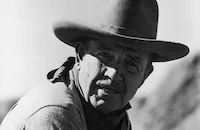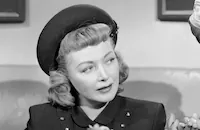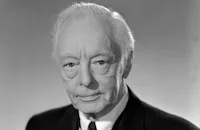Legion of Terror
Brief Synopsis
Cast & Crew
C. C. Coleman Jr.
Bruce Cabot
Marguerite Churchill
Crawford Weaver
Ward Bond
Charles Wilson
Film Details
Technical Specs

Synopsis
In Washington, D.C., Frank Marshall and his friend, Slim Hewitt, are sworn in as postal inspectors. After a bomb is found in the Senate mailroom, sent from Stanfield, Connecticut and addressed to Senator Morton, Frank and Slim are sent to Stanfield to investigate. On the train, Frank becomes acquainted with Nancy Foster, a resident of Stanfield. When they arrive, Frank and Slim take on assumed names and get jobs in a local factory. When Frank goes to Nancy's house for dinner, her brother Don tells him that the Hood Legion has complete control of the town. Soon Frank and Slim realize that the factory where they work as well as the local newspaper is in the legion's control. Don has received several threatening letters advising him to join the legion. Frank and Slim successfully infiltrate the group by undergoing an initiation ceremony in which masked members in long robes blindfold Frank and Slim and hold guns to their heads before giving them each a bullet as a token of their membership. When Don complains to local newspaper editor Colonel McCullom about his refusal to print Don's allegations against the legion's nefarious activities, Don is framed and arrested for drunk driving. Although he is released, he is ostracized by the townspeople. McCollum then orders his men to take Don to the legion's secret tribunal in the woods, where Don is tried, found guilty, and shot to death by legion members. Nancy goes to the police, but they are unable to find the killers. When Frank tries to convey his sympathy to Nancy, she forces him to confess his membership in the legion, and vows never to speak to him again. She then goes to the owner of the newspaper with her story, and he upbraids McCollum, causing him to decide that Nancy should be tried by the legion's tribunal. Slim then confronts McCollum with the knowledge that the legion killed Don, and he is taken to the legion's meeting ground to be tried as a traitor. When Frank learns that Nancy and Slim are being held prisoner, he goes to the governor and secures the National Guard, which rescues Nancy and Slim and arrests the legion members. It is then revealed that McCollum was the leader of the legion, after which he and his assistant try to escape, but are burned to death when their car overturns. Frank then reveals his true identity to Nancy, and they make plans to marry. Later, in the post office department in Washington, D.C., the chief inspector congratulates Frank and Slim for their work, but warns them that Americans are a nation of "joiners," and as such are susceptible to organizations such as the Ku Klux Klan and the Hooded Legion, which they join believing they are being patriotic, when in fact they are placing themselves in the hands of racketeers who operate the legions solely for their own benefit.

Director
C. C. Coleman Jr.
Cast

Bruce Cabot

Marguerite Churchill
Crawford Weaver

Ward Bond
Charles Wilson

John Hamilton
Arthur Loft
Nick Copeland
John Tyrrell
Edward Le Saint

Harry Davenport

Edward Keane
Ralph Mccullough
John Elliott
Arthur Rankin
Beatrice Curtis

Ralph Dunn
Edward Peil Sr.
George Chesebro
Ted Mapes
Jack Lowe
Crew

Film Details
Technical Specs

Quotes
Trivia
Notes
This film's working titles were the The Legion of Horror and Hooded Legion. The Variety review commented that this was the first picture to deal with the unmasking of the Detroit Black Legion, which had occurred in May 1935 in Michigan, where Charles Poole, a WPA worker, was killed, and Dayton Dean, a Legion executioner, turned state's evidence at the trial. In 1937, Warner Bros. produced a film titled Black Legion that was also based on the Detroit case. A January 17, 1937 New York Times article about the Warner Bros. film states that the Legion's "stock in trade is blatant 'Americanism' coupled with persecution of those differing in economics and racial viewpoints....a sort of 'America for Americans' jehad in which native-born labor was to carry the banner-and take the risks." Variety called Legion of Terror "an indictment of crackpot politico-fraternal organizations." This film marked Crawford Weaver's film debut.












